Critical Analysis of RN Mary's Care Quality and NMBA Standards
VerifiedAdded on 2022/11/18
|8
|2324
|358
Report
AI Summary
This report provides a critical analysis of the quality of care provided by Registered Nurse (RN) Mary within a residential aged care facility. The analysis evaluates Mary's practice against the Nursing and Midwifery Board of Australia (NMBA) professional standards and ethical code of conduct, highlighting instances of patient neglect, such as unattended patients, failure to maintain hygiene, and excessive time spent away from patients. The report identifies violations of NMBA standards related to patient-centered care, therapeutic relationships, and evidence-based practice. It explores the potential consequences for RN Mary, including peer reporting, supervisor intervention, and possible disciplinary actions such as warnings, personal improvement plans, or even suspension or cancellation of licensure. The report also examines the importance of establishing positive therapeutic relationships, integrating evidence-based nursing interventions, and delivering patient-centered care to achieve positive patient outcomes and maintain compliance with professional standards. References to relevant literature are included to support the analysis and recommendations.
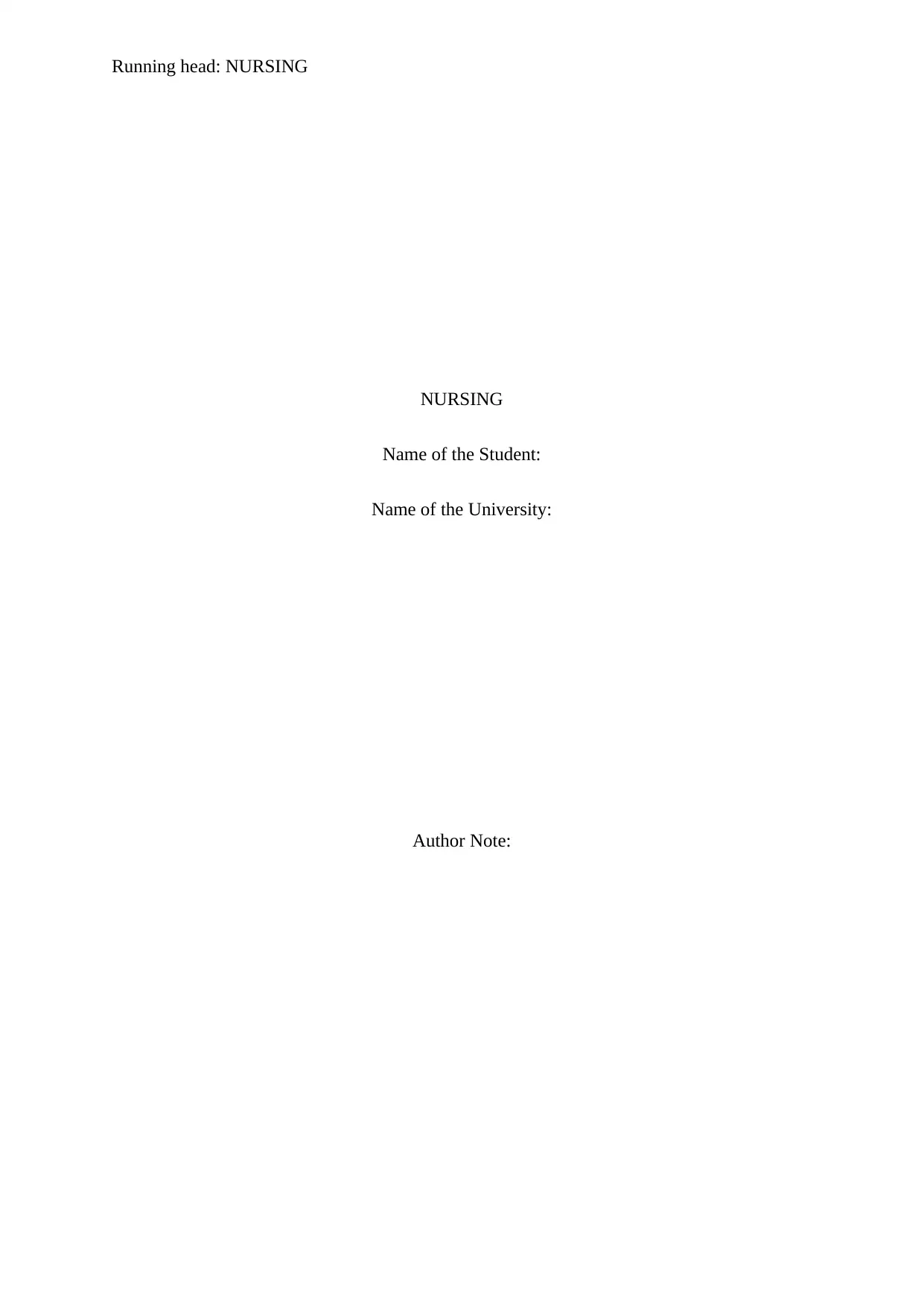
Running head: NURSING
NURSING
Name of the Student:
Name of the University:
Author Note:
NURSING
Name of the Student:
Name of the University:
Author Note:
Paraphrase This Document
Need a fresh take? Get an instant paraphrase of this document with our AI Paraphraser
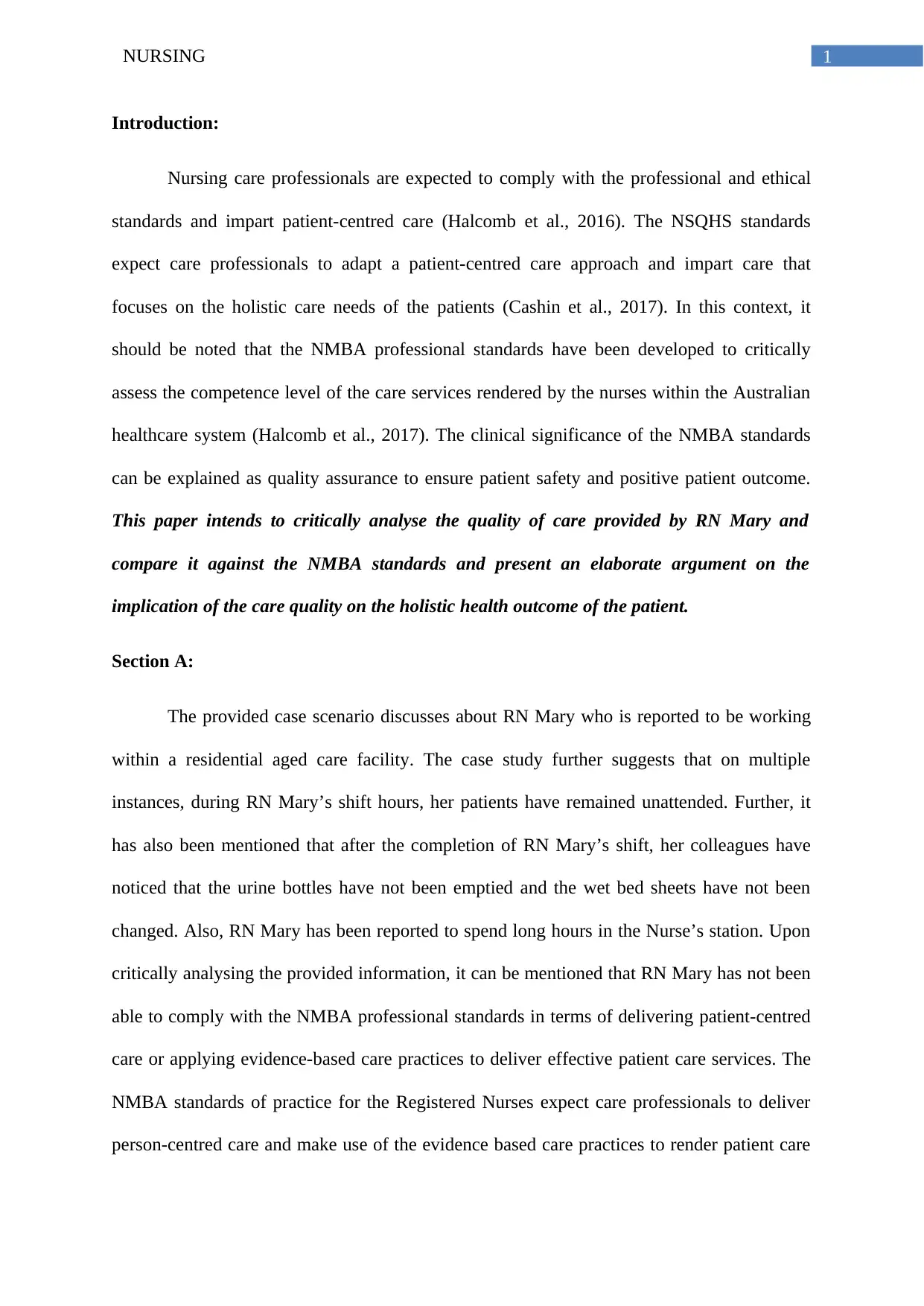
1NURSING
Introduction:
Nursing care professionals are expected to comply with the professional and ethical
standards and impart patient-centred care (Halcomb et al., 2016). The NSQHS standards
expect care professionals to adapt a patient-centred care approach and impart care that
focuses on the holistic care needs of the patients (Cashin et al., 2017). In this context, it
should be noted that the NMBA professional standards have been developed to critically
assess the competence level of the care services rendered by the nurses within the Australian
healthcare system (Halcomb et al., 2017). The clinical significance of the NMBA standards
can be explained as quality assurance to ensure patient safety and positive patient outcome.
This paper intends to critically analyse the quality of care provided by RN Mary and
compare it against the NMBA standards and present an elaborate argument on the
implication of the care quality on the holistic health outcome of the patient.
Section A:
The provided case scenario discusses about RN Mary who is reported to be working
within a residential aged care facility. The case study further suggests that on multiple
instances, during RN Mary’s shift hours, her patients have remained unattended. Further, it
has also been mentioned that after the completion of RN Mary’s shift, her colleagues have
noticed that the urine bottles have not been emptied and the wet bed sheets have not been
changed. Also, RN Mary has been reported to spend long hours in the Nurse’s station. Upon
critically analysing the provided information, it can be mentioned that RN Mary has not been
able to comply with the NMBA professional standards in terms of delivering patient-centred
care or applying evidence-based care practices to deliver effective patient care services. The
NMBA standards of practice for the Registered Nurses expect care professionals to deliver
person-centred care and make use of the evidence based care practices to render patient care
Introduction:
Nursing care professionals are expected to comply with the professional and ethical
standards and impart patient-centred care (Halcomb et al., 2016). The NSQHS standards
expect care professionals to adapt a patient-centred care approach and impart care that
focuses on the holistic care needs of the patients (Cashin et al., 2017). In this context, it
should be noted that the NMBA professional standards have been developed to critically
assess the competence level of the care services rendered by the nurses within the Australian
healthcare system (Halcomb et al., 2017). The clinical significance of the NMBA standards
can be explained as quality assurance to ensure patient safety and positive patient outcome.
This paper intends to critically analyse the quality of care provided by RN Mary and
compare it against the NMBA standards and present an elaborate argument on the
implication of the care quality on the holistic health outcome of the patient.
Section A:
The provided case scenario discusses about RN Mary who is reported to be working
within a residential aged care facility. The case study further suggests that on multiple
instances, during RN Mary’s shift hours, her patients have remained unattended. Further, it
has also been mentioned that after the completion of RN Mary’s shift, her colleagues have
noticed that the urine bottles have not been emptied and the wet bed sheets have not been
changed. Also, RN Mary has been reported to spend long hours in the Nurse’s station. Upon
critically analysing the provided information, it can be mentioned that RN Mary has not been
able to comply with the NMBA professional standards in terms of delivering patient-centred
care or applying evidence-based care practices to deliver effective patient care services. The
NMBA standards of practice for the Registered Nurses expect care professionals to deliver
person-centred care and make use of the evidence based care practices to render patient care
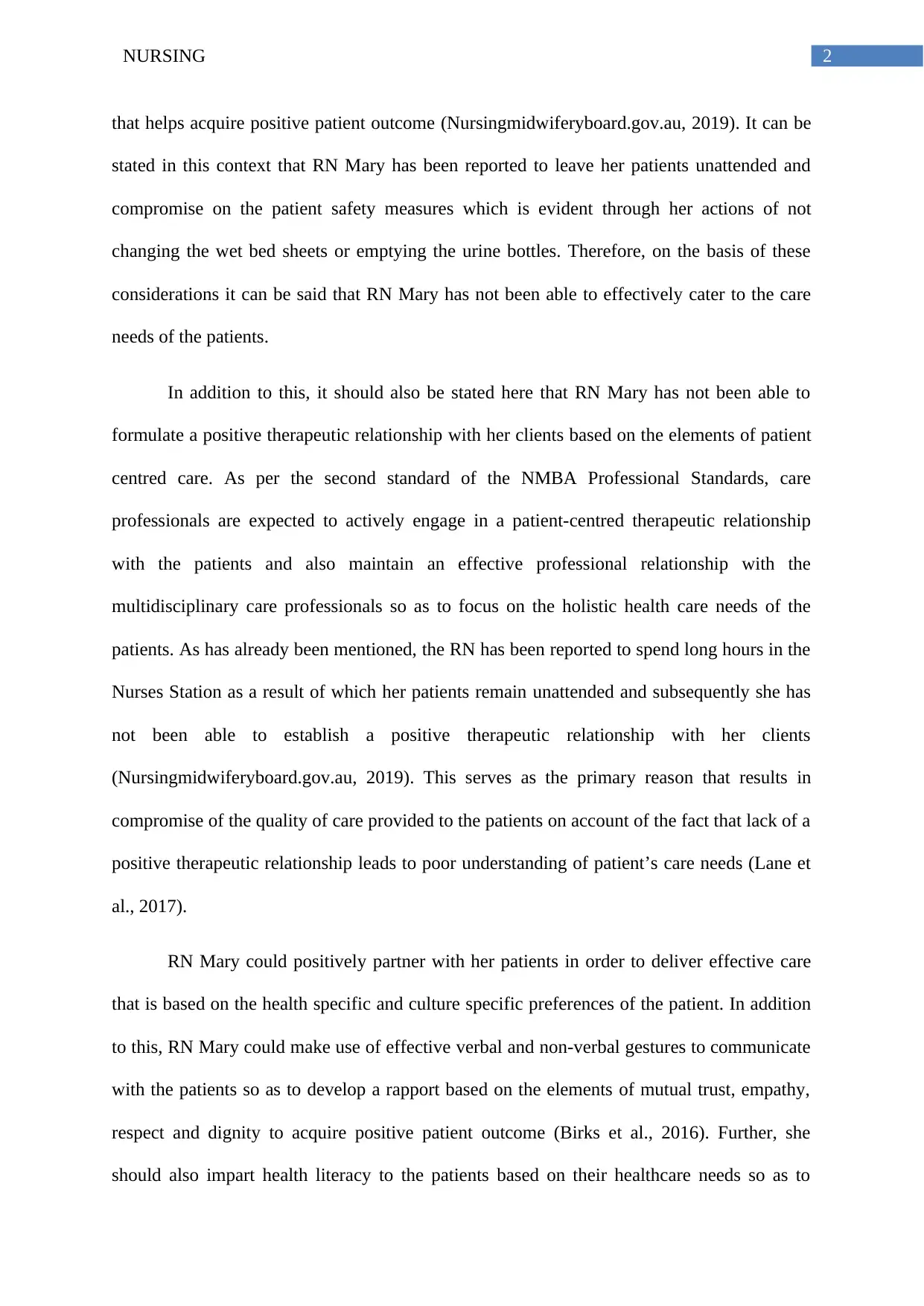
2NURSING
that helps acquire positive patient outcome (Nursingmidwiferyboard.gov.au, 2019). It can be
stated in this context that RN Mary has been reported to leave her patients unattended and
compromise on the patient safety measures which is evident through her actions of not
changing the wet bed sheets or emptying the urine bottles. Therefore, on the basis of these
considerations it can be said that RN Mary has not been able to effectively cater to the care
needs of the patients.
In addition to this, it should also be stated here that RN Mary has not been able to
formulate a positive therapeutic relationship with her clients based on the elements of patient
centred care. As per the second standard of the NMBA Professional Standards, care
professionals are expected to actively engage in a patient-centred therapeutic relationship
with the patients and also maintain an effective professional relationship with the
multidisciplinary care professionals so as to focus on the holistic health care needs of the
patients. As has already been mentioned, the RN has been reported to spend long hours in the
Nurses Station as a result of which her patients remain unattended and subsequently she has
not been able to establish a positive therapeutic relationship with her clients
(Nursingmidwiferyboard.gov.au, 2019). This serves as the primary reason that results in
compromise of the quality of care provided to the patients on account of the fact that lack of a
positive therapeutic relationship leads to poor understanding of patient’s care needs (Lane et
al., 2017).
RN Mary could positively partner with her patients in order to deliver effective care
that is based on the health specific and culture specific preferences of the patient. In addition
to this, RN Mary could make use of effective verbal and non-verbal gestures to communicate
with the patients so as to develop a rapport based on the elements of mutual trust, empathy,
respect and dignity to acquire positive patient outcome (Birks et al., 2016). Further, she
should also impart health literacy to the patients based on their healthcare needs so as to
that helps acquire positive patient outcome (Nursingmidwiferyboard.gov.au, 2019). It can be
stated in this context that RN Mary has been reported to leave her patients unattended and
compromise on the patient safety measures which is evident through her actions of not
changing the wet bed sheets or emptying the urine bottles. Therefore, on the basis of these
considerations it can be said that RN Mary has not been able to effectively cater to the care
needs of the patients.
In addition to this, it should also be stated here that RN Mary has not been able to
formulate a positive therapeutic relationship with her clients based on the elements of patient
centred care. As per the second standard of the NMBA Professional Standards, care
professionals are expected to actively engage in a patient-centred therapeutic relationship
with the patients and also maintain an effective professional relationship with the
multidisciplinary care professionals so as to focus on the holistic health care needs of the
patients. As has already been mentioned, the RN has been reported to spend long hours in the
Nurses Station as a result of which her patients remain unattended and subsequently she has
not been able to establish a positive therapeutic relationship with her clients
(Nursingmidwiferyboard.gov.au, 2019). This serves as the primary reason that results in
compromise of the quality of care provided to the patients on account of the fact that lack of a
positive therapeutic relationship leads to poor understanding of patient’s care needs (Lane et
al., 2017).
RN Mary could positively partner with her patients in order to deliver effective care
that is based on the health specific and culture specific preferences of the patient. In addition
to this, RN Mary could make use of effective verbal and non-verbal gestures to communicate
with the patients so as to develop a rapport based on the elements of mutual trust, empathy,
respect and dignity to acquire positive patient outcome (Birks et al., 2016). Further, she
should also impart health literacy to the patients based on their healthcare needs so as to
⊘ This is a preview!⊘
Do you want full access?
Subscribe today to unlock all pages.

Trusted by 1+ million students worldwide
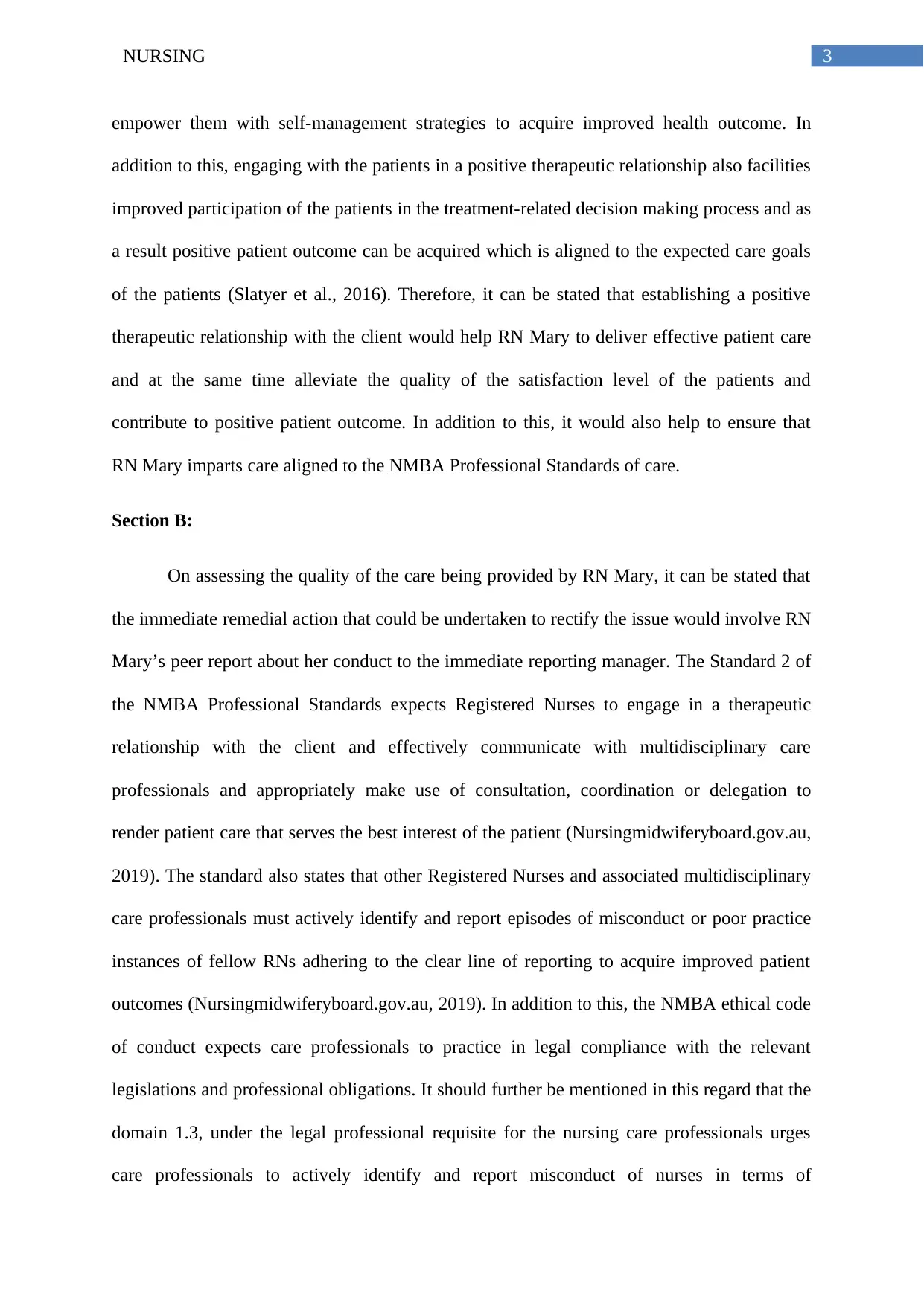
3NURSING
empower them with self-management strategies to acquire improved health outcome. In
addition to this, engaging with the patients in a positive therapeutic relationship also facilities
improved participation of the patients in the treatment-related decision making process and as
a result positive patient outcome can be acquired which is aligned to the expected care goals
of the patients (Slatyer et al., 2016). Therefore, it can be stated that establishing a positive
therapeutic relationship with the client would help RN Mary to deliver effective patient care
and at the same time alleviate the quality of the satisfaction level of the patients and
contribute to positive patient outcome. In addition to this, it would also help to ensure that
RN Mary imparts care aligned to the NMBA Professional Standards of care.
Section B:
On assessing the quality of the care being provided by RN Mary, it can be stated that
the immediate remedial action that could be undertaken to rectify the issue would involve RN
Mary’s peer report about her conduct to the immediate reporting manager. The Standard 2 of
the NMBA Professional Standards expects Registered Nurses to engage in a therapeutic
relationship with the client and effectively communicate with multidisciplinary care
professionals and appropriately make use of consultation, coordination or delegation to
render patient care that serves the best interest of the patient (Nursingmidwiferyboard.gov.au,
2019). The standard also states that other Registered Nurses and associated multidisciplinary
care professionals must actively identify and report episodes of misconduct or poor practice
instances of fellow RNs adhering to the clear line of reporting to acquire improved patient
outcomes (Nursingmidwiferyboard.gov.au, 2019). In addition to this, the NMBA ethical code
of conduct expects care professionals to practice in legal compliance with the relevant
legislations and professional obligations. It should further be mentioned in this regard that the
domain 1.3, under the legal professional requisite for the nursing care professionals urges
care professionals to actively identify and report misconduct of nurses in terms of
empower them with self-management strategies to acquire improved health outcome. In
addition to this, engaging with the patients in a positive therapeutic relationship also facilities
improved participation of the patients in the treatment-related decision making process and as
a result positive patient outcome can be acquired which is aligned to the expected care goals
of the patients (Slatyer et al., 2016). Therefore, it can be stated that establishing a positive
therapeutic relationship with the client would help RN Mary to deliver effective patient care
and at the same time alleviate the quality of the satisfaction level of the patients and
contribute to positive patient outcome. In addition to this, it would also help to ensure that
RN Mary imparts care aligned to the NMBA Professional Standards of care.
Section B:
On assessing the quality of the care being provided by RN Mary, it can be stated that
the immediate remedial action that could be undertaken to rectify the issue would involve RN
Mary’s peer report about her conduct to the immediate reporting manager. The Standard 2 of
the NMBA Professional Standards expects Registered Nurses to engage in a therapeutic
relationship with the client and effectively communicate with multidisciplinary care
professionals and appropriately make use of consultation, coordination or delegation to
render patient care that serves the best interest of the patient (Nursingmidwiferyboard.gov.au,
2019). The standard also states that other Registered Nurses and associated multidisciplinary
care professionals must actively identify and report episodes of misconduct or poor practice
instances of fellow RNs adhering to the clear line of reporting to acquire improved patient
outcomes (Nursingmidwiferyboard.gov.au, 2019). In addition to this, the NMBA ethical code
of conduct expects care professionals to practice in legal compliance with the relevant
legislations and professional obligations. It should further be mentioned in this regard that the
domain 1.3, under the legal professional requisite for the nursing care professionals urges
care professionals to actively identify and report misconduct of nurses in terms of
Paraphrase This Document
Need a fresh take? Get an instant paraphrase of this document with our AI Paraphraser
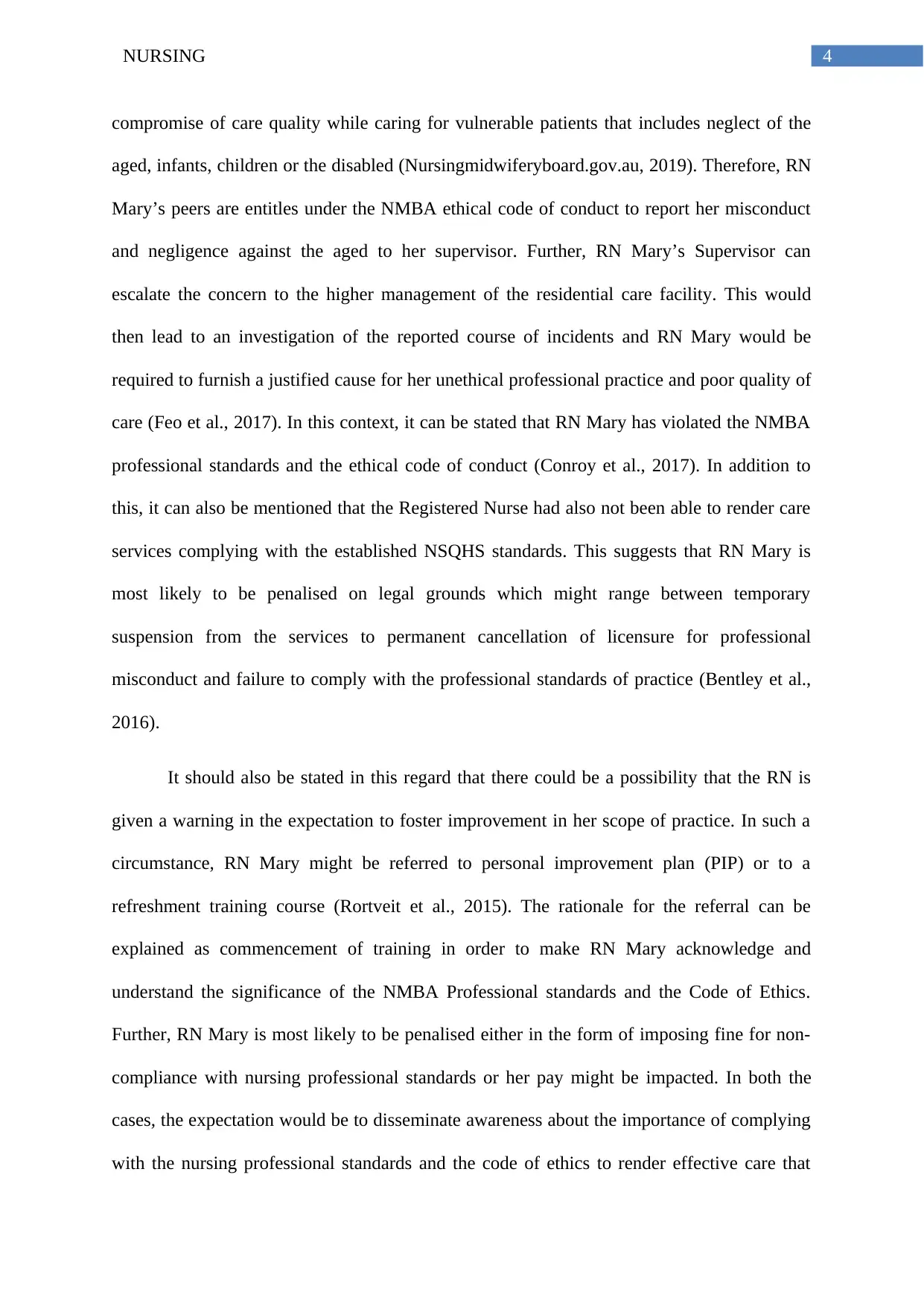
4NURSING
compromise of care quality while caring for vulnerable patients that includes neglect of the
aged, infants, children or the disabled (Nursingmidwiferyboard.gov.au, 2019). Therefore, RN
Mary’s peers are entitles under the NMBA ethical code of conduct to report her misconduct
and negligence against the aged to her supervisor. Further, RN Mary’s Supervisor can
escalate the concern to the higher management of the residential care facility. This would
then lead to an investigation of the reported course of incidents and RN Mary would be
required to furnish a justified cause for her unethical professional practice and poor quality of
care (Feo et al., 2017). In this context, it can be stated that RN Mary has violated the NMBA
professional standards and the ethical code of conduct (Conroy et al., 2017). In addition to
this, it can also be mentioned that the Registered Nurse had also not been able to render care
services complying with the established NSQHS standards. This suggests that RN Mary is
most likely to be penalised on legal grounds which might range between temporary
suspension from the services to permanent cancellation of licensure for professional
misconduct and failure to comply with the professional standards of practice (Bentley et al.,
2016).
It should also be stated in this regard that there could be a possibility that the RN is
given a warning in the expectation to foster improvement in her scope of practice. In such a
circumstance, RN Mary might be referred to personal improvement plan (PIP) or to a
refreshment training course (Rortveit et al., 2015). The rationale for the referral can be
explained as commencement of training in order to make RN Mary acknowledge and
understand the significance of the NMBA Professional standards and the Code of Ethics.
Further, RN Mary is most likely to be penalised either in the form of imposing fine for non-
compliance with nursing professional standards or her pay might be impacted. In both the
cases, the expectation would be to disseminate awareness about the importance of complying
with the nursing professional standards and the code of ethics to render effective care that
compromise of care quality while caring for vulnerable patients that includes neglect of the
aged, infants, children or the disabled (Nursingmidwiferyboard.gov.au, 2019). Therefore, RN
Mary’s peers are entitles under the NMBA ethical code of conduct to report her misconduct
and negligence against the aged to her supervisor. Further, RN Mary’s Supervisor can
escalate the concern to the higher management of the residential care facility. This would
then lead to an investigation of the reported course of incidents and RN Mary would be
required to furnish a justified cause for her unethical professional practice and poor quality of
care (Feo et al., 2017). In this context, it can be stated that RN Mary has violated the NMBA
professional standards and the ethical code of conduct (Conroy et al., 2017). In addition to
this, it can also be mentioned that the Registered Nurse had also not been able to render care
services complying with the established NSQHS standards. This suggests that RN Mary is
most likely to be penalised on legal grounds which might range between temporary
suspension from the services to permanent cancellation of licensure for professional
misconduct and failure to comply with the professional standards of practice (Bentley et al.,
2016).
It should also be stated in this regard that there could be a possibility that the RN is
given a warning in the expectation to foster improvement in her scope of practice. In such a
circumstance, RN Mary might be referred to personal improvement plan (PIP) or to a
refreshment training course (Rortveit et al., 2015). The rationale for the referral can be
explained as commencement of training in order to make RN Mary acknowledge and
understand the significance of the NMBA Professional standards and the Code of Ethics.
Further, RN Mary is most likely to be penalised either in the form of imposing fine for non-
compliance with nursing professional standards or her pay might be impacted. In both the
cases, the expectation would be to disseminate awareness about the importance of complying
with the nursing professional standards and the code of ethics to render effective care that
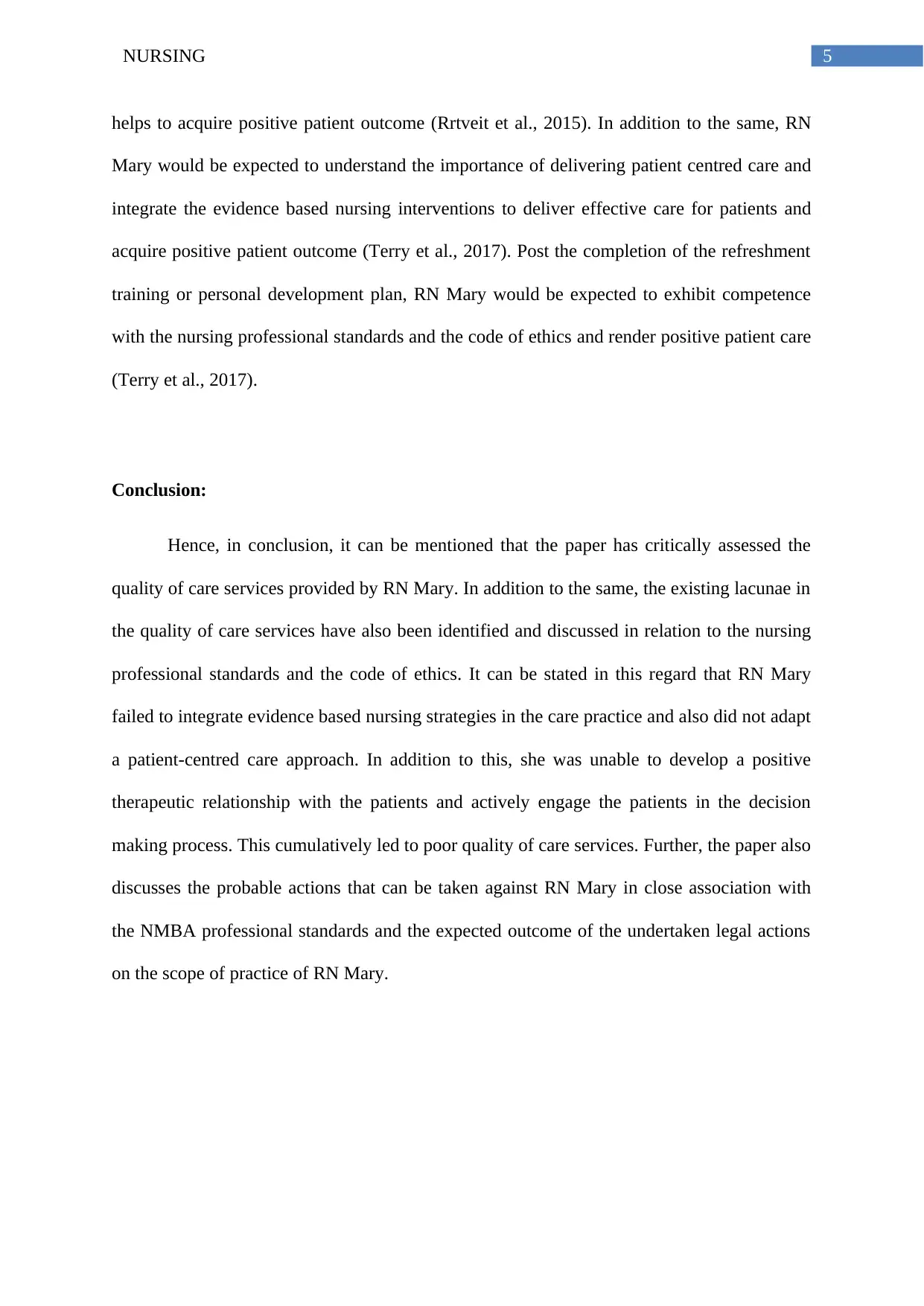
5NURSING
helps to acquire positive patient outcome (Rrtveit et al., 2015). In addition to the same, RN
Mary would be expected to understand the importance of delivering patient centred care and
integrate the evidence based nursing interventions to deliver effective care for patients and
acquire positive patient outcome (Terry et al., 2017). Post the completion of the refreshment
training or personal development plan, RN Mary would be expected to exhibit competence
with the nursing professional standards and the code of ethics and render positive patient care
(Terry et al., 2017).
Conclusion:
Hence, in conclusion, it can be mentioned that the paper has critically assessed the
quality of care services provided by RN Mary. In addition to the same, the existing lacunae in
the quality of care services have also been identified and discussed in relation to the nursing
professional standards and the code of ethics. It can be stated in this regard that RN Mary
failed to integrate evidence based nursing strategies in the care practice and also did not adapt
a patient-centred care approach. In addition to this, she was unable to develop a positive
therapeutic relationship with the patients and actively engage the patients in the decision
making process. This cumulatively led to poor quality of care services. Further, the paper also
discusses the probable actions that can be taken against RN Mary in close association with
the NMBA professional standards and the expected outcome of the undertaken legal actions
on the scope of practice of RN Mary.
helps to acquire positive patient outcome (Rrtveit et al., 2015). In addition to the same, RN
Mary would be expected to understand the importance of delivering patient centred care and
integrate the evidence based nursing interventions to deliver effective care for patients and
acquire positive patient outcome (Terry et al., 2017). Post the completion of the refreshment
training or personal development plan, RN Mary would be expected to exhibit competence
with the nursing professional standards and the code of ethics and render positive patient care
(Terry et al., 2017).
Conclusion:
Hence, in conclusion, it can be mentioned that the paper has critically assessed the
quality of care services provided by RN Mary. In addition to the same, the existing lacunae in
the quality of care services have also been identified and discussed in relation to the nursing
professional standards and the code of ethics. It can be stated in this regard that RN Mary
failed to integrate evidence based nursing strategies in the care practice and also did not adapt
a patient-centred care approach. In addition to this, she was unable to develop a positive
therapeutic relationship with the patients and actively engage the patients in the decision
making process. This cumulatively led to poor quality of care services. Further, the paper also
discusses the probable actions that can be taken against RN Mary in close association with
the NMBA professional standards and the expected outcome of the undertaken legal actions
on the scope of practice of RN Mary.
⊘ This is a preview!⊘
Do you want full access?
Subscribe today to unlock all pages.

Trusted by 1+ million students worldwide
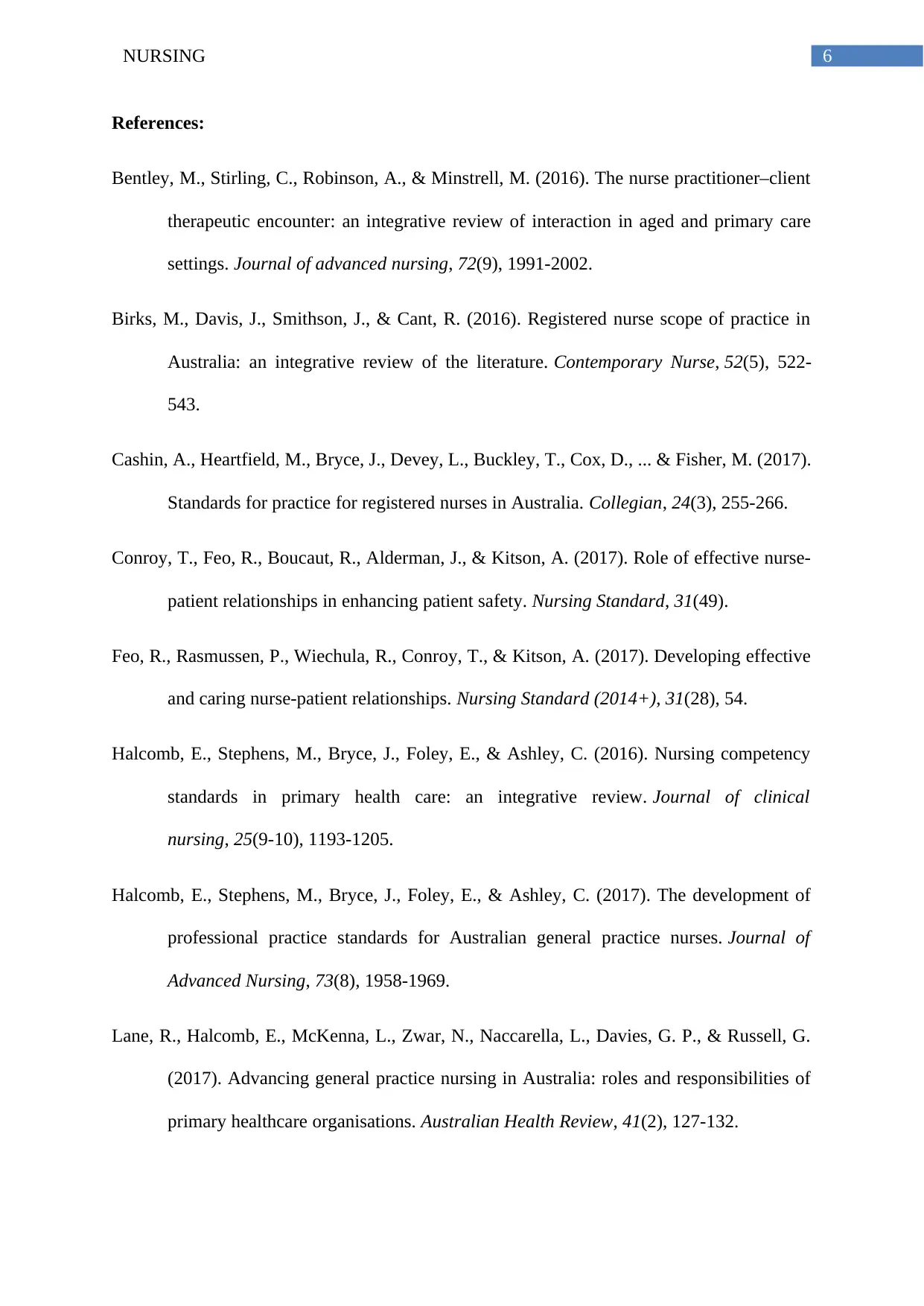
6NURSING
References:
Bentley, M., Stirling, C., Robinson, A., & Minstrell, M. (2016). The nurse practitioner–client
therapeutic encounter: an integrative review of interaction in aged and primary care
settings. Journal of advanced nursing, 72(9), 1991-2002.
Birks, M., Davis, J., Smithson, J., & Cant, R. (2016). Registered nurse scope of practice in
Australia: an integrative review of the literature. Contemporary Nurse, 52(5), 522-
543.
Cashin, A., Heartfield, M., Bryce, J., Devey, L., Buckley, T., Cox, D., ... & Fisher, M. (2017).
Standards for practice for registered nurses in Australia. Collegian, 24(3), 255-266.
Conroy, T., Feo, R., Boucaut, R., Alderman, J., & Kitson, A. (2017). Role of effective nurse-
patient relationships in enhancing patient safety. Nursing Standard, 31(49).
Feo, R., Rasmussen, P., Wiechula, R., Conroy, T., & Kitson, A. (2017). Developing effective
and caring nurse-patient relationships. Nursing Standard (2014+), 31(28), 54.
Halcomb, E., Stephens, M., Bryce, J., Foley, E., & Ashley, C. (2016). Nursing competency
standards in primary health care: an integrative review. Journal of clinical
nursing, 25(9-10), 1193-1205.
Halcomb, E., Stephens, M., Bryce, J., Foley, E., & Ashley, C. (2017). The development of
professional practice standards for Australian general practice nurses. Journal of
Advanced Nursing, 73(8), 1958-1969.
Lane, R., Halcomb, E., McKenna, L., Zwar, N., Naccarella, L., Davies, G. P., & Russell, G.
(2017). Advancing general practice nursing in Australia: roles and responsibilities of
primary healthcare organisations. Australian Health Review, 41(2), 127-132.
References:
Bentley, M., Stirling, C., Robinson, A., & Minstrell, M. (2016). The nurse practitioner–client
therapeutic encounter: an integrative review of interaction in aged and primary care
settings. Journal of advanced nursing, 72(9), 1991-2002.
Birks, M., Davis, J., Smithson, J., & Cant, R. (2016). Registered nurse scope of practice in
Australia: an integrative review of the literature. Contemporary Nurse, 52(5), 522-
543.
Cashin, A., Heartfield, M., Bryce, J., Devey, L., Buckley, T., Cox, D., ... & Fisher, M. (2017).
Standards for practice for registered nurses in Australia. Collegian, 24(3), 255-266.
Conroy, T., Feo, R., Boucaut, R., Alderman, J., & Kitson, A. (2017). Role of effective nurse-
patient relationships in enhancing patient safety. Nursing Standard, 31(49).
Feo, R., Rasmussen, P., Wiechula, R., Conroy, T., & Kitson, A. (2017). Developing effective
and caring nurse-patient relationships. Nursing Standard (2014+), 31(28), 54.
Halcomb, E., Stephens, M., Bryce, J., Foley, E., & Ashley, C. (2016). Nursing competency
standards in primary health care: an integrative review. Journal of clinical
nursing, 25(9-10), 1193-1205.
Halcomb, E., Stephens, M., Bryce, J., Foley, E., & Ashley, C. (2017). The development of
professional practice standards for Australian general practice nurses. Journal of
Advanced Nursing, 73(8), 1958-1969.
Lane, R., Halcomb, E., McKenna, L., Zwar, N., Naccarella, L., Davies, G. P., & Russell, G.
(2017). Advancing general practice nursing in Australia: roles and responsibilities of
primary healthcare organisations. Australian Health Review, 41(2), 127-132.
Paraphrase This Document
Need a fresh take? Get an instant paraphrase of this document with our AI Paraphraser
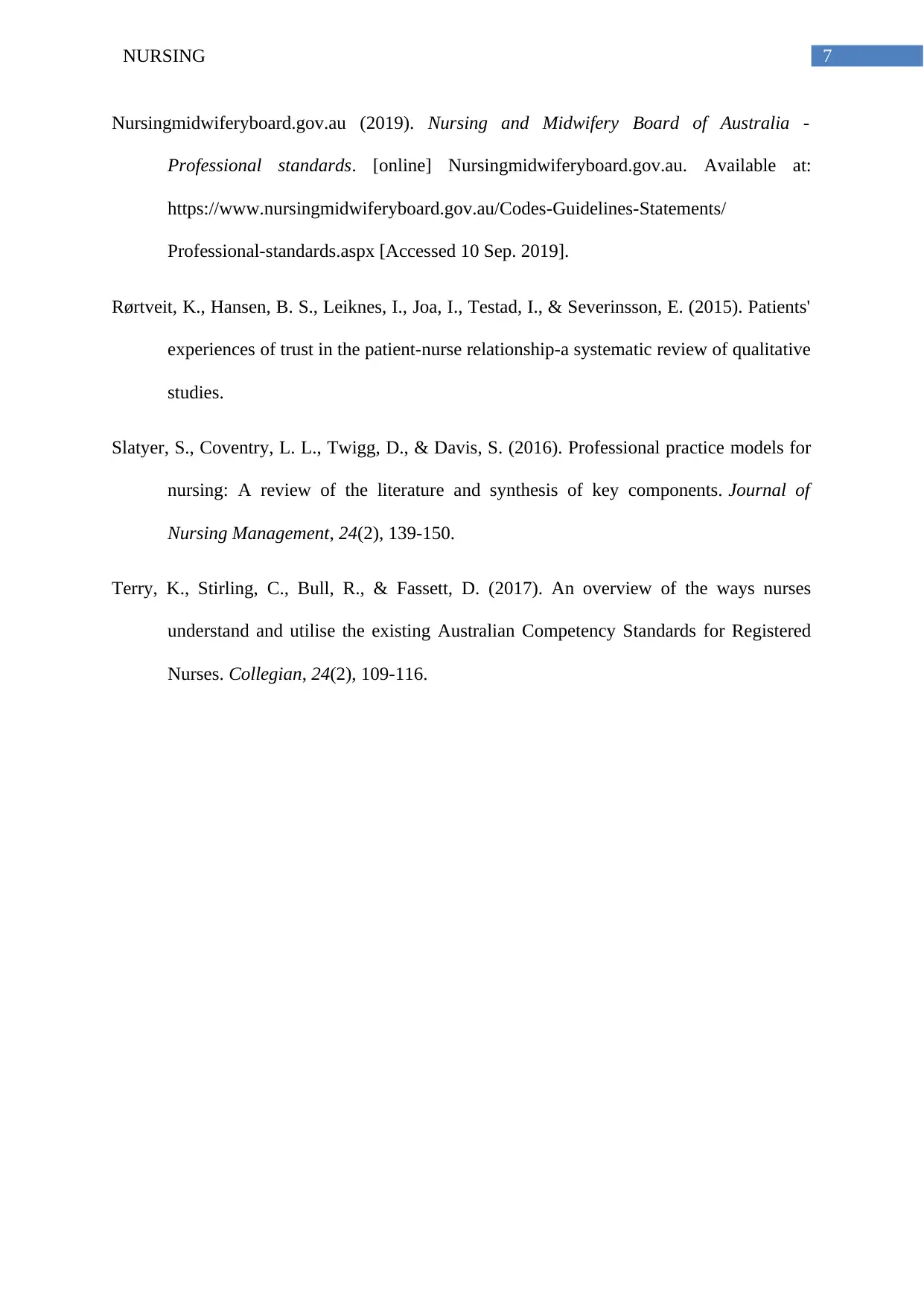
7NURSING
Nursingmidwiferyboard.gov.au (2019). Nursing and Midwifery Board of Australia -
Professional standards. [online] Nursingmidwiferyboard.gov.au. Available at:
https://www.nursingmidwiferyboard.gov.au/Codes-Guidelines-Statements/
Professional-standards.aspx [Accessed 10 Sep. 2019].
Rørtveit, K., Hansen, B. S., Leiknes, I., Joa, I., Testad, I., & Severinsson, E. (2015). Patients'
experiences of trust in the patient-nurse relationship-a systematic review of qualitative
studies.
Slatyer, S., Coventry, L. L., Twigg, D., & Davis, S. (2016). Professional practice models for
nursing: A review of the literature and synthesis of key components. Journal of
Nursing Management, 24(2), 139-150.
Terry, K., Stirling, C., Bull, R., & Fassett, D. (2017). An overview of the ways nurses
understand and utilise the existing Australian Competency Standards for Registered
Nurses. Collegian, 24(2), 109-116.
Nursingmidwiferyboard.gov.au (2019). Nursing and Midwifery Board of Australia -
Professional standards. [online] Nursingmidwiferyboard.gov.au. Available at:
https://www.nursingmidwiferyboard.gov.au/Codes-Guidelines-Statements/
Professional-standards.aspx [Accessed 10 Sep. 2019].
Rørtveit, K., Hansen, B. S., Leiknes, I., Joa, I., Testad, I., & Severinsson, E. (2015). Patients'
experiences of trust in the patient-nurse relationship-a systematic review of qualitative
studies.
Slatyer, S., Coventry, L. L., Twigg, D., & Davis, S. (2016). Professional practice models for
nursing: A review of the literature and synthesis of key components. Journal of
Nursing Management, 24(2), 139-150.
Terry, K., Stirling, C., Bull, R., & Fassett, D. (2017). An overview of the ways nurses
understand and utilise the existing Australian Competency Standards for Registered
Nurses. Collegian, 24(2), 109-116.
1 out of 8
Related Documents
Your All-in-One AI-Powered Toolkit for Academic Success.
+13062052269
info@desklib.com
Available 24*7 on WhatsApp / Email
![[object Object]](/_next/static/media/star-bottom.7253800d.svg)
Unlock your academic potential
Copyright © 2020–2025 A2Z Services. All Rights Reserved. Developed and managed by ZUCOL.





